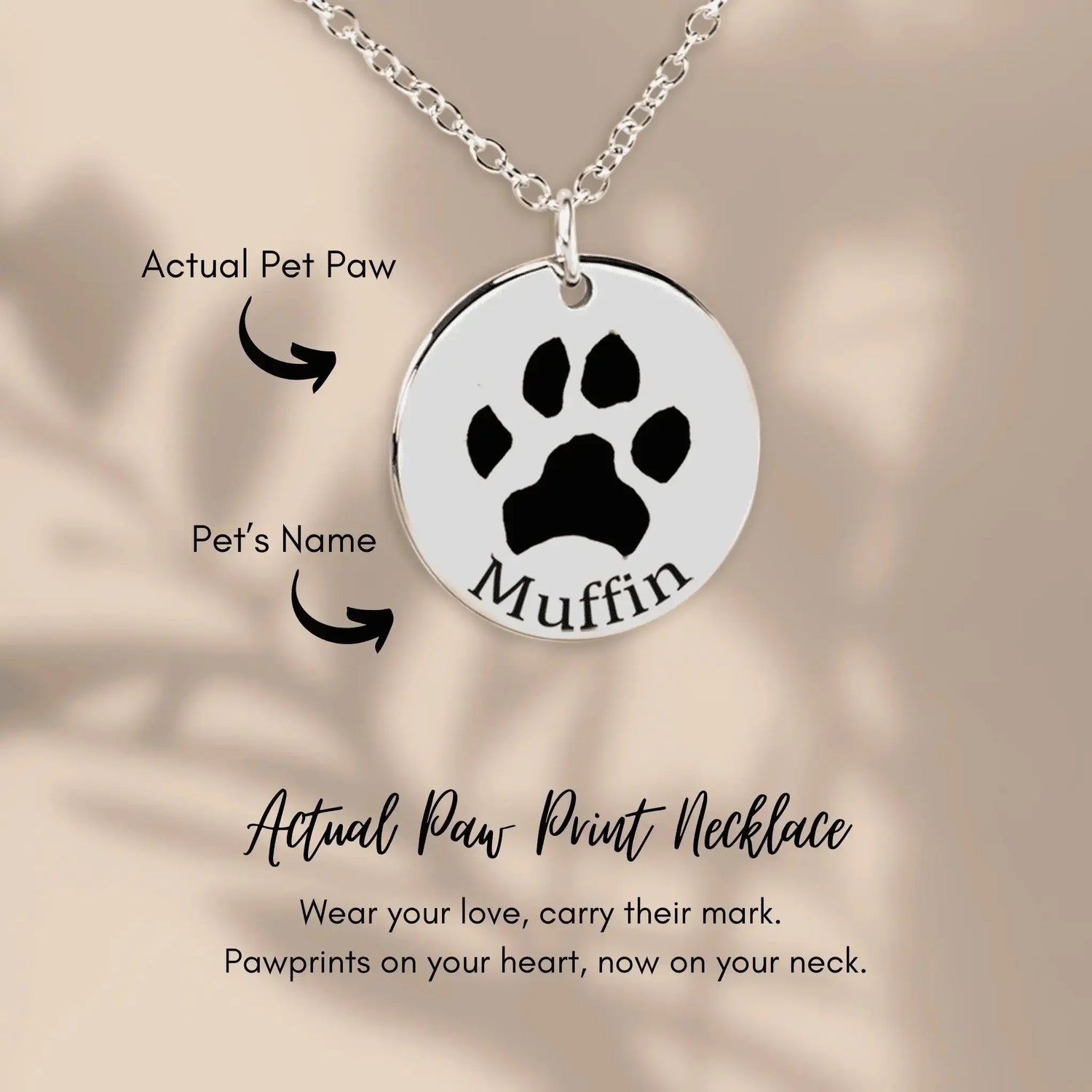Cats With Curly Hair: A Paw-some Guide to Wavy Wonders
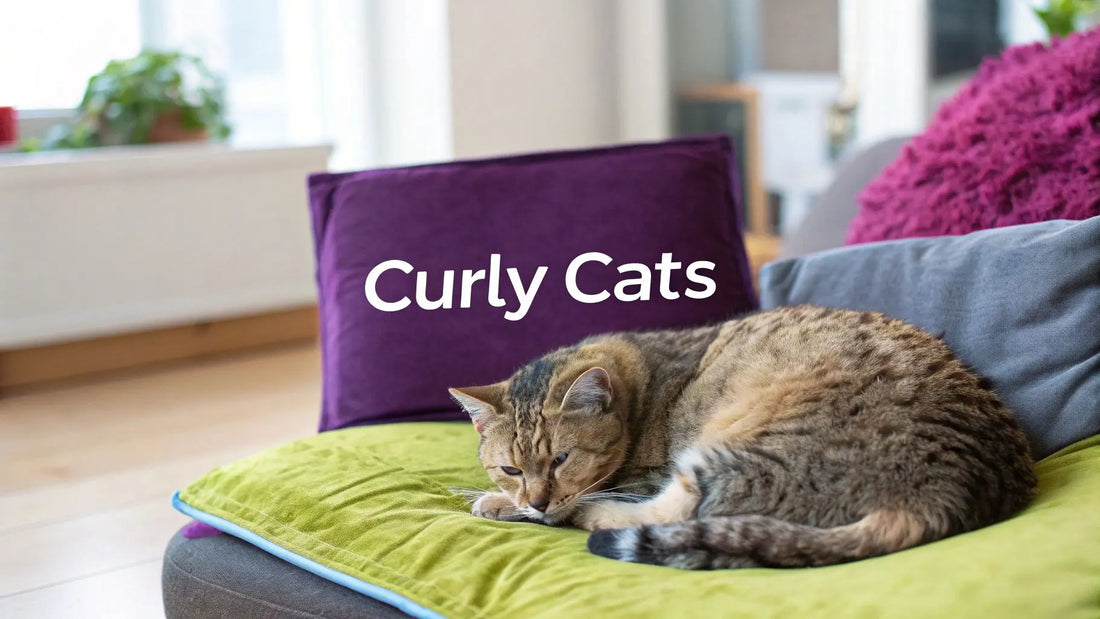
Ever stumbled across a cat that looks like it’s rocking a permanent wave? ✨ If so, you've witnessed the enchanting magic of cats with curly hair! These incredible felines, often called Rex breeds, are turning heads in the cat world with their uniquely wavy coats. Our mascot, Floofie, is purr-fectly thrilled to give you the grand tour! 😻
Welcome to the Wavy World of Curly Cats
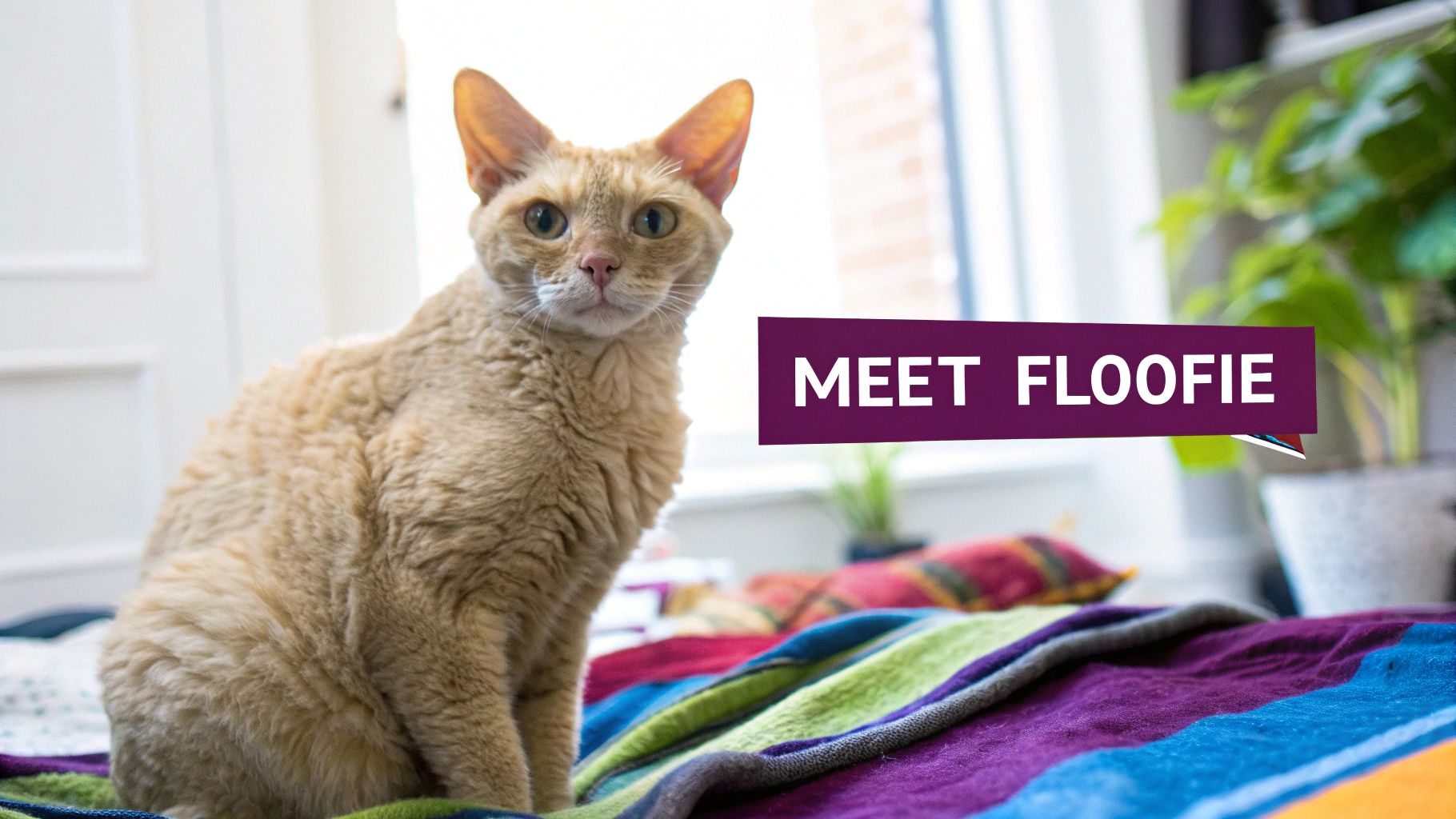
Get ready to meet some of the most exclusive kitties on the block, with our mascot Floofie leading the tour! These cats aren't your everyday tabbies; they're walking, purring works of art with coats that range from soft, gentle waves to tight, plush ringlets.
This distinctive fur isn't a salon job—it's the result of a completely natural genetic mutation. Think of it like human hair. Some of us have straight hair, some have waves, and others have curls. These cats just happened to win the genetic lottery for a "perm-anent" look, making each one a truly special find. 💖
This guide is your all-access pass to understanding everything about these captivating companions.
What Makes Them So Special
So, what’s all the fuss about? Beyond their show-stopping appearance, curly-haired cats are famous for their charming, affectionate personalities. Trust me, they're so much more than just a pretty coat!
Here’s a quick look at what makes them so irresistible:
- Unique Coats: Their fur can feel like anything from crushed velvet to a cozy wool sweater. It's a tactile experience unlike any other cat you've petted. Petting them is a total treat!
- Playful Personalities: Many Rex breeds are known for being incredibly energetic, curious, and social—some are even a bit dog-like in their antics! They're always up for a good romp.
- Rare and Precious: You won't find these breeds in every shelter. Their rarity makes being owned by one a truly special journey for any dedicated cat lover. If you're thinking of bringing one home, our guide for the first-time cat owner can help you get ready for one of these rare gems.
As our pal Floofie would say, "A curly cat isn't just a pet; it's a fluffy, purring masterpiece!" 🎨
This guide will walk you through the most popular curly breeds, the science behind their fabulous fur, and the special care they need to thrive. Let's dive in and meet the stars of the show!
Meet the Main Curly Cat Breeds
Alright, let's dive into the A-listers of the curly cat world. Each one has its own unique coat and a personality to match, so it's time to get familiar with what makes these curly-haired cats so incredibly special.
The Elegant Cornish Rex
First up, meet the sophisticated Cornish Rex. If you can imagine petting a cat made from the softest crushed velvet, you’re getting close. Their coat is all tight, gentle waves that sit close to their body, giving them a sleek, runway-ready look.
These cats are basically the supermodels of the feline universe, complete with high cheekbones, huge ears, and a slender, athletic build. But they're not just about looks! Cornish Rex cats are major socialites and absolutely live to be the center of attention. They keep their kitten-like energy for years, always ready for a game of fetch or a wild chase after a laser dot.
The Playful Pixie Devon Rex
Next on the tour is the whimsical Devon Rex. If the Cornish is a supermodel, the Devon is the enchanting pixie of the group. With their massive ears, wide-set eyes, and short little muzzles, they have this endearing, elf-like face that's impossible to say no to. Their coat feels like soft suede, with loose, rippling curls.
Devons are the ultimate social butterflies. They're fiercely loyal and form incredibly strong bonds with their people, often shadowing their favorite human from room to room. Their playful, mischievous streak means they're always up for an adventure. Our mascot Floofie is pretty sure they'd go nuts for an interactive toy like the FloofChonk UFO Smart Cat Toy to keep their clever minds occupied! 🛸
The Teddy Bear Selkirk Rex
Now, get ready for the plushest of them all: the Selkirk Rex! This breed is the literal teddy bear of the cat world, rocking a thick, woolly coat with loose, unstructured curls. Unlike the other Rexes, the Selkirk has a full, dense coat that just makes you want to snuggle up and never let go. They come in both long-haired and short-haired versions, but both are equally cuddly.
The Selkirk Rex is a true gentle giant. They have a patient, calm, and loving personality that makes them fantastic family companions. While they definitely enjoy a good play session, they're just as content to be a lap cat, purring away while you relax.
Fun fact: The Selkirk Rex is a relative newcomer to the cat scene. The whole breed started with a single curly-haired kitten born to a rescued cat in Montana way back in 1987! That kitten, named Miss DiPesto, was bred with a Persian, and her dominant curly-hair gene was passed down. It proved you only need one parent with the gene to create these woolly wonders. You can learn more about the Selkirk Rex's unique origins in this fascinating genetic study.
A Rare Gem: The LaPerm
Last but certainly not least, let's talk about a lesser-known but equally fabulous curly cat—the LaPerm. Just like their name suggests, these cats look like they just stepped out of a salon with a fresh perm! Their coats can be anything from soft waves to tight, springy ringlets, often giving them a wonderfully shaggy look.
LaPerms are known for being incredibly affectionate and curious. They crave human contact and will often reach out with a paw to gently tap you for attention. These clever cats love being involved in whatever you’re doing, whether it’s "helping" you work from home or supervising your cooking. They are true companions in every sense of the word.
The Science Behind Their Unique Coats
So, what’s the real story behind those incredible, sheep-like curls? It’s not some fancy new-fangled salon treatment—it's all written right into their DNA! 🧬
These one-of-a-kind coats are the result of a spontaneous genetic mutation. Think of it as a happy little accident in the feline family tree that gave us the permanent wave we can't get enough of.
A Recipe for Curls
Let's imagine a cat's DNA is a giant recipe book for creating a kitty from scratch. The "Rex" gene is a specific instruction in that book that tells the hair follicles to grow differently, leading to those signature curls.
But here’s where it gets really interesting: not all curls are created equal!
Each of the main curly breeds—the Cornish, Devon, and Selkirk Rex—has its own completely unique genetic recipe for waviness. They're all technically "Rex" cats, but the specific mutation is different for each one. This means a Cornish Rex's gene for curls is totally separate from a Devon Rex's.
It’s this genetic independence that explains why you can't just breed a Cornish Rex with a Devon Rex and expect a whole litter of curly kittens. Because their "curl" genes are in different locations in their DNA, breeding them together would most likely give you straight-haired kittens! It's kind of like trying to bake a cake using two totally different recipes at once—the results would be, well, unpredictable.
Our mascot Floofie thinks this makes each curly breed extra special, like a limited-edition piece of art! Each one is a product of its own unique genetic journey.
The differences in their genes explain why each breed has such a distinct coat texture. It's the reason a Cornish Rex feels like velvet while a Selkirk Rex feels like a plush woolly blanket!
To get a better picture of these curly family trees, this concept map shows how each major Rex breed branches out with its own signature look.
This visual really highlights that while they all fall under the "curly cat" umbrella, each breed's genetic path led to very different outcomes, from sleek and wavy to big-eared and fluffy.
Understanding their coat genetics is a bit like appreciating the differences between a Calico and a Tortoiseshell cat. Both are gorgeous, but their patterns come from distinct genetic instructions. You can learn more about Calico and Tortoiseshell cat differences in our detailed guide! This genetic diversity is what makes the world of cats with curly hair so endlessly fascinating. 🐾
How Rare Are Cats With Curly Hair
Have you ever spotted a cat with curly hair and wondered if you were seeing things? You're not alone! These wavy-coated wonders are the feline world's version of a four-leaf clover—unusual, enchanting, and incredibly hard to find. 🍀
While there are over 600 million cats on the planet, from sleek Siamese to majestic Maine Coons, our curly-haired pals make up a minuscule fraction of that number. They are true gems in the vast sea of felines, and their rarity is what makes them so special. It's not just a cool fact; it’s a reality that shapes what it's like to own one.
To put it in perspective, for every few hundred pedigreed cats you might come across, you'd be lucky to see a single one with a curly coat. This exclusivity is a huge part of their charm!
The Curly Cat Club Is Super Exclusive
So, just how small is this curly cat club? The numbers might surprise you. As a group, curly-haired breeds are exceptionally uncommon, making up less than 1% of all pedigreed cats registered each year in big markets like the US and Europe. Even as more people fall in love with them, the combined global population of all major curly-coated breeds is estimated to be under 50,000. You can discover more insights about their rarity to see just how unique these kitties are.
This means you’re not likely to find a Selkirk Rex or a Devon Rex just waiting for you at a local shelter. Finding one of these special cats usually means connecting with dedicated, reputable breeders who are passionate about keeping these unique genetic lines healthy and thriving.
As our mascot Floofie likes to say, "Being part of the curly cat crew means you're basically a celebrity. Pawsitively famous!" 🐾
Because there are so few of them, bringing one of these companions home often takes a bit of patience. Many hopeful owners end up on waiting lists, sometimes for a year or even longer, for the chance to welcome a curly kitten into their lives.
Why Are They So Hard to Find
A few key things contribute to the rarity of cats with curly hair, making them prized pets for those lucky enough to have one.
- Spontaneous Mutations: Every Rex breed started with a random, natural genetic quirk. These aren't "designer breeds" created in a lab; they're beautiful accidents of nature that careful breeders have worked hard to preserve.
- Specialized Breeding Programs: Keeping a small gene pool healthy requires incredibly responsible breeding. It’s not as simple as pairing two curly cats together. Breeders have to meticulously plan every litter to ensure the health and genetic diversity of the kittens.
- Growing Popularity: While they're still rare, their fame is on the rise! More and more people are falling for their unique looks and charming personalities, which, of course, can make those waitlists even longer.
Their scarcity isn't a drawback—it's a testament to how precious they really are. Welcoming one of these rare felines into your home is a special journey, and it all starts with understanding what makes them one-of-a-kind.
Grooming Your Curly Coated Companion
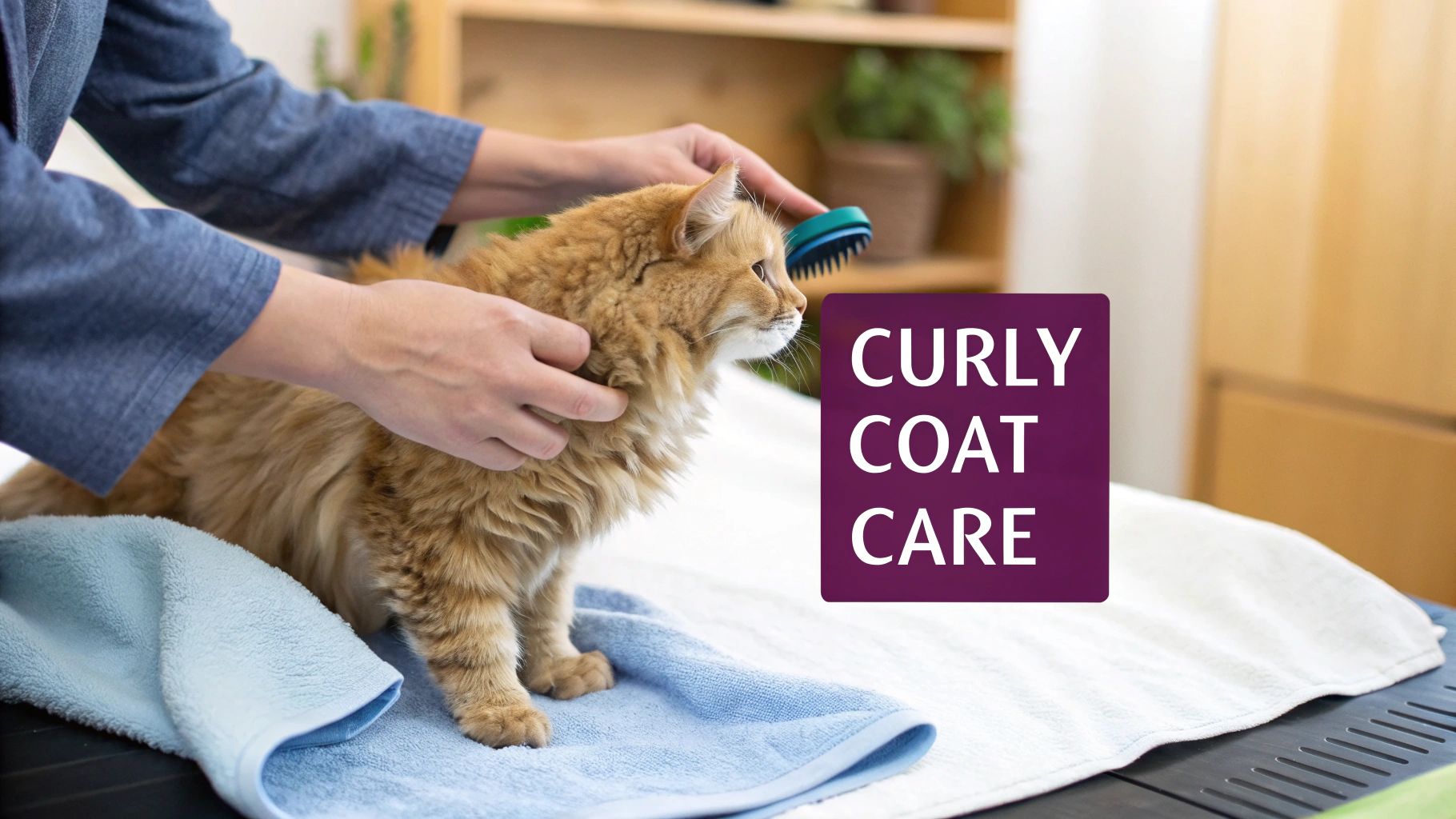
Those gorgeous, springy curls are the star of the show, but they do need a little special attention to stay fabulous! 😻 Don't worry, grooming cats with curly hair is simpler than it looks, and it's a purr-fect way to bond with your wavy wonder. Our mascot Floofie is here to spill all the best grooming secrets!
The most important rule of the curly cat club is this: do not over-brush! It's so tempting to want to smooth out their fur constantly, but too much brushing can quickly lead to a frizzy disaster. Those delicate curls can break easily, turning their unique coat into a poofy mess instead of a collection of defined ringlets.
Finding the Purr-fect Tools
Standard brushes are a big no-no for these kitties. Instead, you'll want to build a small grooming kit designed specifically for their delicate fur. Think gentle and soft!
Here are Floofie's top picks for keeping those curls in tip-top shape:
- Soft Rubber Curry Brush: This is your secret weapon! The gentle rubber nubs are fantastic for removing loose hair and dirt without snagging or pulling on their curls. Our mascot Floofie absolutely adores the Floofie's Favorite Grooming Glove, which feels just like a relaxing massage to him.
- Wide-Toothed Comb: For any stubborn tangles, especially in longer-haired breeds like the Selkirk Rex, a wide-toothed comb is essential. Just be sure to use it sparingly and gently work through any knots to avoid breakage.
A gentle grooming session once or twice a week is usually all it takes to keep your curly companion looking their best. The key is consistency, not intensity!
Bath Time for Your Wavy Wonder 🛁
Unlike most cats, your curly-coated friend might actually need occasional baths. Their unique fur structure can sometimes trap skin oils, leading to a greasy feeling over time. But don't break out the shampoo too often—a bath every few months is typically enough unless they get into something messy.
When it's time for a scrub, use a high-quality, moisturizing cat shampoo. Lather gently, rinse thoroughly, and then let your cat air-dry or pat them carefully with a soft towel. Whatever you do, never rub them dry! This will create instant frizz and ruin those beautiful curls.
Grooming techniques can definitely vary by coat type, and you can discover more general tips in our guide to the long-haired orange tabby cat. Keeping your feline friend looking and feeling great is a reward in itself.
Common Health and Wellness Questions
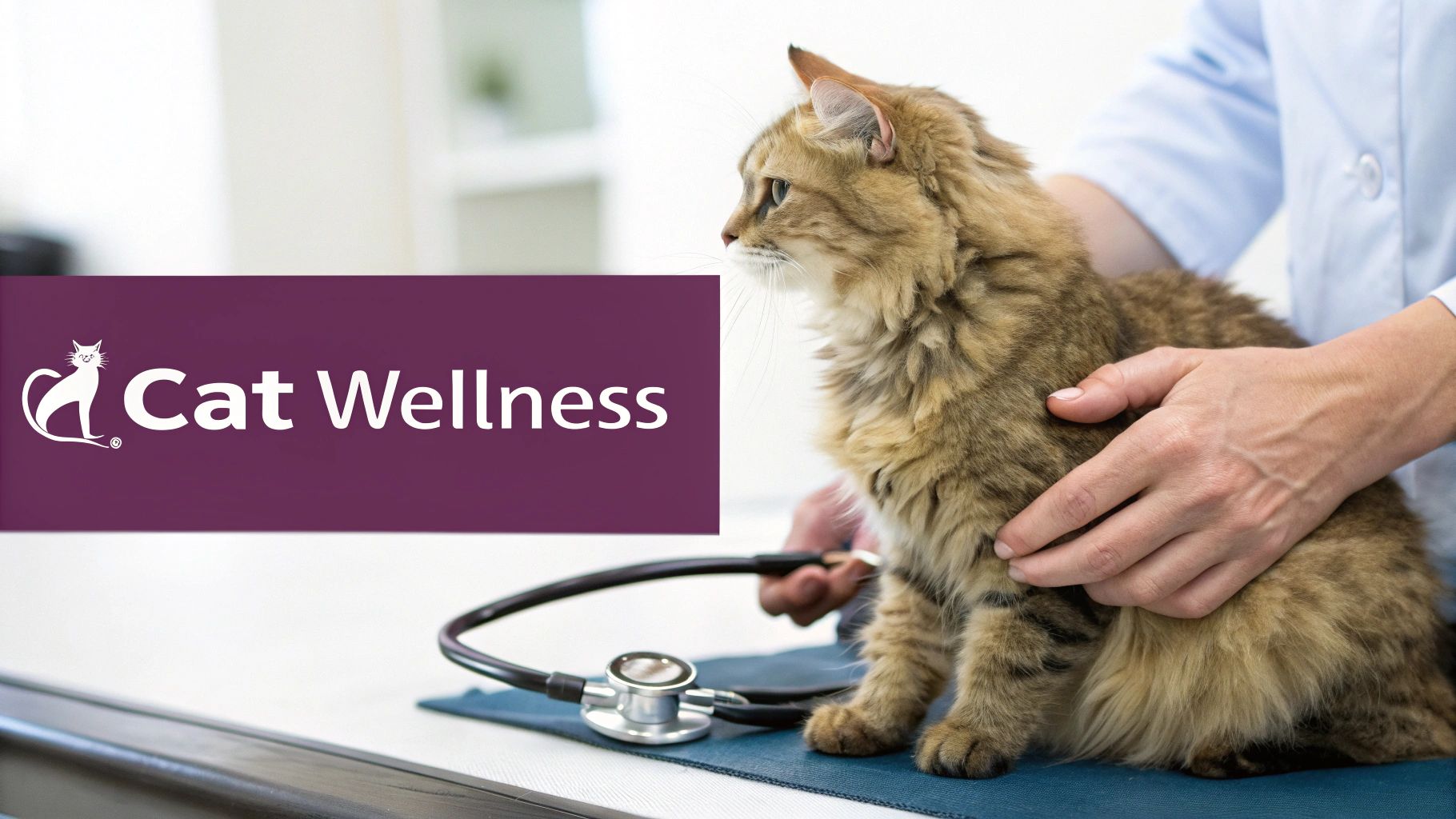
Keeping your curly companion healthy and purring is priority number one! While generally pretty tough little cookies, the unique genetics behind cats with curly hair mean they have a few special wellness quirks to keep an eye on. But don't you worry, Floofie and I are here to walk you through it. 💖
These breeds are just as hearty as any other cat, but that special coat can sometimes lead to skin sensitivities. Because their fur can be a little sparse in places, their skin is more exposed to the elements and potential irritants. This just means you might notice some occasional dryness or oiliness, which is totally normal!
Watch Out for Skin and Ear Health
One of the most common things to pop up for curly cats is skin irritation. Think of it like this: their unique coat can't always wick away oils as effectively as a standard dense coat can. This can sometimes lead to minor skin issues or even small, itchy scabs—a condition known as miliary dermatitis.
Similarly, those adorable, oversized ears (I'm looking at you, Devon Rex) can be prone to wax buildup. A little extra gunk in there can become a perfect party spot for yeast and bacteria if you don't stay on top of it. 🎉
To keep them feeling their absolute best, Floofie suggests:
- Regular Ear Checks: Gently peek inside their ears once a week. If you spot wax, use a vet-approved gentle cleaner with a cotton ball—never a Q-tip!
- Skin Patrol: While you’re petting your cat, feel for any unusual bumps, scabs, or greasy spots. Catching things early makes everything easier to handle.
- A Top-Notch Diet: A balanced diet rich in omega fatty acids can do wonders for their skin and coat. Floofie is a huge fan of the Floofie's Favorite Fish Oil Supplement to keep his own fur looking fabulous.
Just like us, some cats can develop environmental or food allergies that show up as skin problems. If you notice persistent scratching or hair loss, it’s always best to chat with your vet to rule out allergies.
Creating a Happy and Stimulating Home
Beyond their physical health, these intelligent and social cats need plenty of mental stimulation to really thrive. A bored curly cat is a mischievous one! 😼 Providing an enriching environment is just as important as feeding them the right food.
Invest in some puzzle feeders, interactive toys, and tall cat trees to keep their clever minds and athletic bodies busy. Scheduling daily playtime is a fantastic way to bond with your kitty and burn off some of that famous Rex energy. Our mascot Floofie personally recommends the FloofChonk UFO Smart Cat Toy to keep your curly friend entertained for hours.
By looking after both their physical and mental well-being, you'll ensure your special companion lives a long, happy, and healthy life.
Your Burning Questions About Curly Cats
Got a few more questions rattling around in your head about these wavy wonders? Don't worry, you're not alone. Let's tackle some of the most common curiosities about cats with curly hair.
Are Cats With Curly Hair Hypoallergenic?
Ah, the million-dollar question! While no cat on earth is 100% hypoallergenic, many people with mild cat allergies report they can live more comfortably with some of the Rex breeds.
It comes down to this: cats like the Cornish and Devon Rex have way less fur and don't shed nearly as much as your average housecat. That means fewer of those pesky, allergy-inducing proteins (like the notorious Fel d 1) floating around your home and landing on your furniture.
But here's the real talk: it’s not a magic bullet. If you have allergies, the absolute best thing you can do is spend some quality time with the specific breed you're crushing on before you commit to bringing one home.
So, How Much Do These Cats Cost?
Brace your wallet. Because they're pretty rare and require careful, specialized breeding, curly-haired cats definitely come with a higher price tag than more common breeds. You can expect to pay anywhere from $1,200 to over $2,500 for a kitten from a reputable breeder.
That price tag should cover initial vaccinations, a health guarantee, and proof of pedigree. A word of caution: if you see a price that seems too good to be true, it probably is. A bargain from an unverified source might save you money upfront, but it could lead to heartbreaking health and behavioral problems down the road.
What Is Their Average Lifespan?
With the right care, a ton of love, and a good diet, these curly kitties can live long, fantastic lives. Their average lifespan is pretty much on par with most domestic cats, usually falling in the 12 to 15 year range. We've even seen some live well into their late teens!
Keeping them happy and healthy isn't rocket science, but it does take consistency.
- Routine Vet Visits: Think of these as your cat's wellness checks. Regular visits help you catch any potential issues before they become big problems.
- A Balanced Diet: High-quality food is non-negotiable. It's the fuel that supports their unique skin and that fabulous coat.
- Lots and Lots of Playtime: An active cat is a happy cat! They need daily playtime and interaction to keep their minds and bodies sharp.
At FloofChonk, we're obsessed with celebrating every single cat, whether their fur is curly, straight, or somewhere in between. From quirky apparel that shows off your cat-parent pride to engaging toys for your best fur-end, we’ve got everything you need. Head over to our collection at floofchonk.com to find the purr-fect gear for you and your favorite fluffball! 🐾
